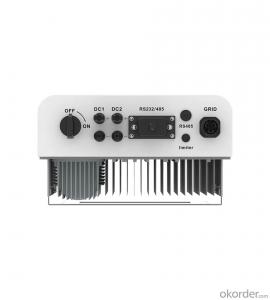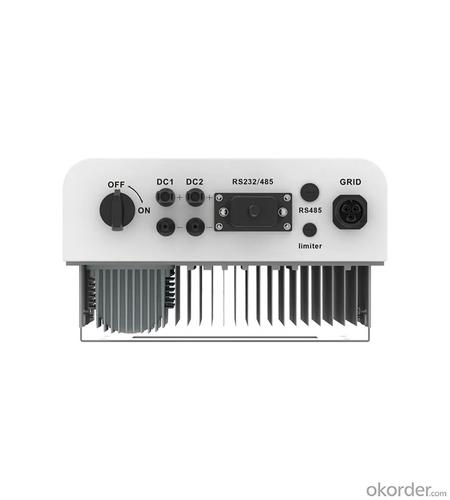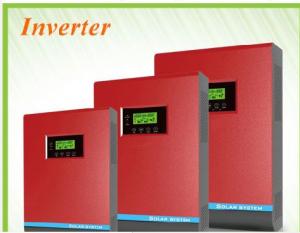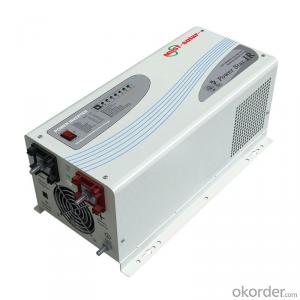Portable Solar Inverter - Sun-3.6/4/4.6/5/6k-g | 3.6-6kW | Single Phase | 2 MPPT
- Loading Port:
- Ningbo
- Payment Terms:
- TT OR LC
- Min Order Qty:
- 100 pc
- Supply Capability:
- 5000 pc/month
OKorder Service Pledge
Quality Product, Order Online Tracking, Timely Delivery
OKorder Financial Service
Credit Rating, Credit Services, Credit Purchasing
You Might Also Like
Specification
Output Power:
3.6kw-6kw
Inveter Efficiency:
97.1%-97.3%
Output Voltage(V):
220
Input Voltage(V):
550
Output Current(A):
15.7-26.1
Output Frequency:
50/60Hz
| Model | SUN-3.6K-G | SUN-4K-G | SUN-4.6K-G | SUN-5K-G | SUN-6K-G |
| Input Side | |||||
| Max. DC Input Power (kW) | 4.7 | 5.2 | 5.98 | 6.5 | 7.8 |
| Max. DC Input Voltage (V) | 550 | ||||
| Start-up DC Input Voltage (V) | 80 | ||||
| MPPT Operating Range (V) | 70~500 | ||||
| Max. DC Input Current (A) | 13+13 | ||||
| Max. Short Circuit Current (A) | 19.5+19.5 | ||||
| Number of MPPT / Strings per MPPT | 2/1 | ||||
| Output Side | |||||
| Rated Output Power (kW) | 3.6 | 4 | 4.6 | 5 | 6 |
| Max. Active Power (kW) | 3.96 | 4.4 | 5.06 | 5.5 | 6.6 |
| Nominal Output Voltage / Range (V) | L/N/PE 220V/0.85Un-1.1Un, 230V/0.85Un-1.1Un (Optional) | ||||
| Rated Grid Frequency (Hz) | 50 / 60 (Optional) | ||||
| Operating Phase | Single phase | ||||
| Rated AC Grid Output Current (A) | 15.7 | 17.4 | 20 | 21.7 | 26.1 |
| Max. AC Output Current (A) | 17.2 | 19.1 | 22 | 23.9 | 28.7 |
| Output Power Factor | 0.8 leading to 0.8 lagging | ||||
| Grid Current THD | <3% | ||||
| DC Injection Current (mA) | <0.5% | ||||
| Grid Frequency Range | 47~52 or 57~62 (Optional) | ||||
| Efficiency | |||||
| Max. Efficiency | 97.3% | 97.5% | 97.5% | 97.5% | 97.5% |
| Euro Efficiency | 97.1% | 97.3% | 97.3% | 97.3% | 97.3% |
| MPPT Efficiency | >99% | ||||
| Protection | |||||
| DC Reverse-Polarity Protection | Yes | ||||
| AC Short Circuit Protection | Yes | ||||
| AC Output Overcurrent Protection | Yes | ||||
| Output Overvoltage Protection | Yes | ||||
| Insulation Resistance Protection | Yes | ||||
| Ground Fault Monitoring | Yes | ||||
| Anti-islanding Protection | Yes | ||||
| Temperature Protection | Yes | ||||
| Integrated DC Switch | Yes | ||||
| Remote software upload | Yes | ||||
| Remote change of operating parameters | Yes | ||||
| Surge protection | DC Type II / AC Type II | ||||
| General Data | |||||
| Size (mm) | 330W×323H×190D | ||||
| Weight (kg) | 7.5 | ||||
| Topology | Transformerless | ||||
| Internal Consumption | <1W (Night) | ||||
| Running Temperature | -25~65℃, >45℃ derating | ||||
| Ingress Protection | IP65 | ||||
| Noise Emission (Typical) | <25 dB | ||||
| Cooling Concept | Natural cooling | ||||
| Max. Operating Altitude Without Derating | 2000m | ||||
| Warranty | 5 years | ||||
| Grid Connection Standard | CEI 0-21, VDE-AR-N 4105, NRS 097, IEC 62116, IEC 61727, G99, G98, VDE 0126-1-1, RD 1699, C10-11 | ||||
| Operating Surroundings Humidity | 0-100% | ||||
| Safety EMC / Standard | IEC/EN 61000-6-1/2/3/4, IEC/EN 62109-1, IEC/EN 62109-2 | ||||
| Features | |||||
| DC Connection | MC-4 mateable | ||||
| IP65 rated plug | |||||
| Display | LCD1602 | ||||
| Interface | RS485/RS232/Wifi/LAN | ||||
The single-phase inverter is one of the best options for residential application thanks to its smaller size and local LCD display, buttons. Also, with built-in zero-export function (external CT is needed), it offers true ease and comfort for PV system operators and installers.
2 MPP tracker, Max. efficiency up to 97.5%
Zero export application, VSG application
String intelligent monitoring (optional)
Wide output voltage range
Anti-PID function (Optional)
- Q: Can a solar inverter be used in a ground-mounted solar tracking system?
- Yes, a solar inverter can be used in a ground-mounted solar tracking system. The solar inverter is responsible for converting the direct current (DC) generated by the solar panels into alternating current (AC) that can be used to power electrical devices or be fed back into the grid. Whether the solar panels are fixed or mounted on a tracking system, the inverter's function remains the same.
- Q: How do you calculate the efficiency of a solar inverter?
- To calculate the efficiency of a solar inverter, you need to divide the output power by the input power and multiply the result by 100 to get a percentage. The formula is: Efficiency = (Output Power / Input Power) * 100.
- Q: What is the role of a solar inverter in preventing electrical faults?
- The role of a solar inverter in preventing electrical faults is to convert the direct current (DC) electricity generated by solar panels into alternating current (AC) electricity that can be used in homes and businesses. In doing so, the inverter helps maintain a stable and consistent flow of electricity, which reduces the risk of electrical faults such as short circuits, overloads, or voltage fluctuations. It also includes various protection mechanisms, such as ground fault detection and interruption, to ensure the safety and reliability of the solar power system.
- Q: What is the role of a surge protector in a solar inverter?
- The role of a surge protector in a solar inverter is to safeguard the inverter and connected electrical equipment from voltage spikes and power surges that can occur due to lightning strikes, grid fluctuations, or other electrical disturbances. It helps to prevent damage to the inverter and ensures the stability and longevity of the solar power system.
- Q: What is the operating temperature range of a solar inverter?
- The operating temperature range of a solar inverter typically varies, but it is commonly between -20°C to 60°C.
- Q: What is the maximum DC voltage that a solar inverter can handle?
- The maximum DC voltage that a solar inverter can handle varies depending on the specific model and design. However, in general, most solar inverters can handle DC voltages up to 1000V or higher. It is important to consult the manufacturer's specifications to determine the maximum DC voltage capacity of a particular solar inverter.
- Q: How does a solar inverter handle voltage sag and swell?
- A solar inverter handles voltage sag and swell by continuously monitoring the input voltage from the solar panels and adjusting its output voltage accordingly. In the case of voltage sag, when the input voltage drops below a certain threshold, the inverter boosts the voltage to maintain a stable output. Similarly, in the case of voltage swell, when the input voltage exceeds a certain limit, the inverter reduces the voltage to prevent any damage to the connected devices. This process ensures that the solar inverter consistently provides a steady and safe electrical supply.
- Q: Can a solar inverter be used with a ground-mounted solar panel system?
- Yes, a solar inverter can be used with a ground-mounted solar panel system. The solar inverter converts the direct current (DC) generated by the solar panels into alternating current (AC) that can be used to power homes or businesses. Whether the solar panels are mounted on the ground or on a roof, they still require an inverter to convert the electricity into a usable form.
- Q: Can a solar inverter be used in systems with different module orientations?
- Yes, a solar inverter can be used in systems with different module orientations. Solar inverters are designed to convert the direct current (DC) generated by solar panels into alternating current (AC) for use in homes or businesses. They are compatible with various module orientations, including those that are east-west or south-facing. The inverter's maximum power point tracking (MPPT) technology allows it to optimize energy production regardless of the module orientation, ensuring efficient utilization of solar energy.
- Q: How does the maximum AC current rating affect the performance of a solar inverter?
- The maximum AC current rating of a solar inverter determines its capacity to handle and convert the DC power generated by solar panels into usable AC power for the electrical grid. A higher maximum AC current rating allows the inverter to handle larger amounts of power, enabling it to support more solar panels or higher power output. This ensures efficient and uninterrupted performance of the solar inverter, allowing it to meet the energy demands of the system and maximize solar energy production.
Send your message to us
Portable Solar Inverter - Sun-3.6/4/4.6/5/6k-g | 3.6-6kW | Single Phase | 2 MPPT
- Loading Port:
- Ningbo
- Payment Terms:
- TT OR LC
- Min Order Qty:
- 100 pc
- Supply Capability:
- 5000 pc/month
OKorder Service Pledge
Quality Product, Order Online Tracking, Timely Delivery
OKorder Financial Service
Credit Rating, Credit Services, Credit Purchasing
Similar products
Hot products
Hot Searches
Related keywords




























